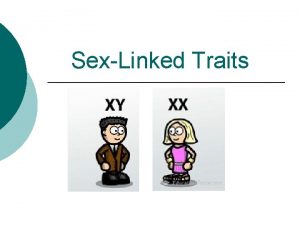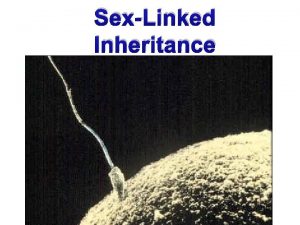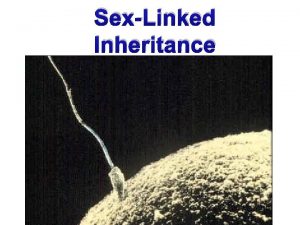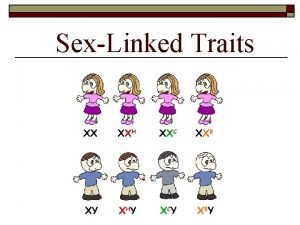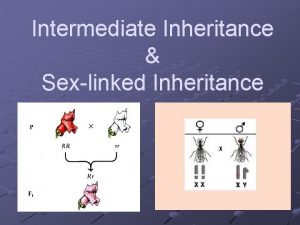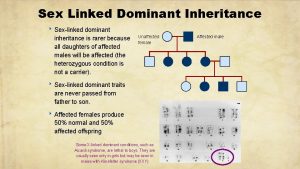Sex determination systems and sexlinked inheritance Sex determination












- Slides: 12

Sex determination systems and sex-linked inheritance

Sex determination Sex chromosome is determined at fertilization time. Early stage fetus contains two ducts system: Wolfian (male). Mullerian (female). Sexual difference starts in the 7 th week. Female X, X and male X, Y.

Genes on the Y chromosome has 78 genes coding for 23 protein. Sex determining region Y (SRY) is exclusively located on Y chromosome and expresses a transcription factor that helps for male development via Turing on testis-determining genes. Turing off ovary-determining genes. Testis releases two hormones: Testosterone and Mullerian inhibiting hormone (MIH)

Testis Testosterone Wolfian duct Male internal genital organ MIH 5 alphareductase Regression of Mullerian duct Male external genital organ

Females develop in the absence of Y. Testosterone is not secreted( wolfian duct degraded). MIH is not secreted (Mullerian system develop).

Fertilized by MALE ♂ Sperm with Y chromosome Egg with X chromosome FEMALE ♀ Sperm with X chromosome Genetic sex Embryo with XY sex chromosomes Embryo with XX sex chromosomes Gonadal sex Y chromosome , So, SRY exist NO Y chromosome , So, NO SRY Testes produces a masculinizing hormones include testosterone and a potent androgen No Testes , so No masculinizing hormones Undifferentiated reproductive track turns into male reproductive system Undifferentiated reproductive track turns into female reproductive system Phenotypic sex

Disorders related to SRY genetic changes Swyer syndrome: SRY gene mutations that cause Swyer syndrome prevent production of the sexdetermining region Y protein or result in the production of a nonfunctioning protein. People with Swyer syndrome have typical female external genitalia. The uterus and fallopian tubes are normally-formed, but the gonads (ovaries or testes) are not functional. Women with this disorder do not produce eggs (ova), but they may be able to become pregnant with a donated egg or embryo.

46, XX testicular disorder of sex development: the condition results from an abnormal exchange of genetic material between chromosomes (translocation). This exchange takes place as a random event during the formation of sperm cells in the affected person's father. The SRY gene is placed in this disorder, almost always onto an X chromosome. A fetus with an X chromosome that carries the SRY gene will develop male characteristics despite not having a Y chromosome. Adults with this disorder are usually shorter than average for males and are unable to have children (infertile).

Sex linked genes: Genes that are located in X and Y chromosome, these tend to have a different patterns of inheritance. However, X-linked genes are more common than Y-linked genes due to containing a bigger number of genes. A female contains two X chromosomes, therefore, will have two copies of each X-linked gene. A male contains a different genotype possibilities than a female. Because, he contains only one X chromosome (paired with a Y), therefore, will have only one copy of any X-linked genes

Case study Hemophilia, a recessive disease in which a person's blood does not clot properly. Gene, that is responsible for hemophilia, is located in X chromosome. XH = functional allele. Xh = disease allele.

Why does NOT it create problem of having just one X copy in male? Males and females have the same dosage of genes, females just express one copy of X chromosome, the other one is inactivated through a process called Xinactivation process. X-inactivation process was addressed by British scientist named Mary F. Lyon. X is compacted and turn into Barr body that contains inactive genes. Cells randomly inactivates X chromosome ( either came form father or mother).

















